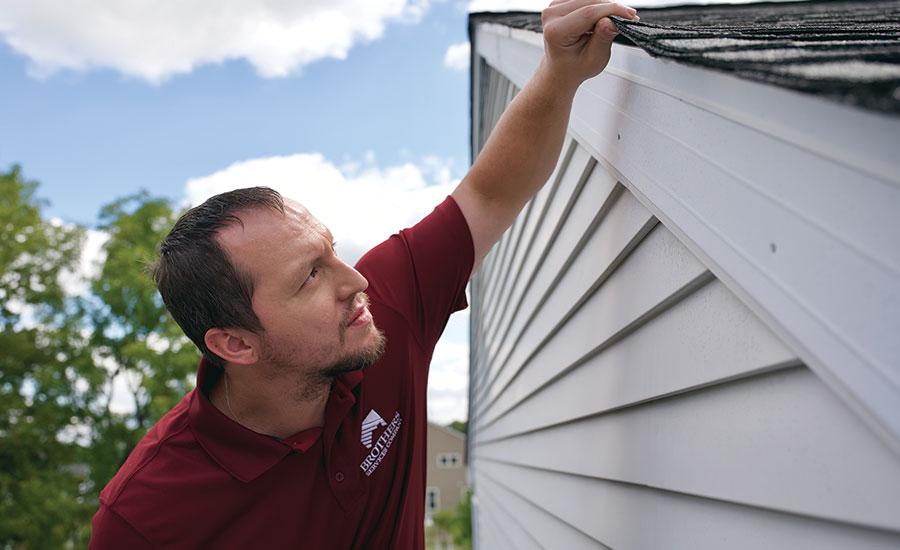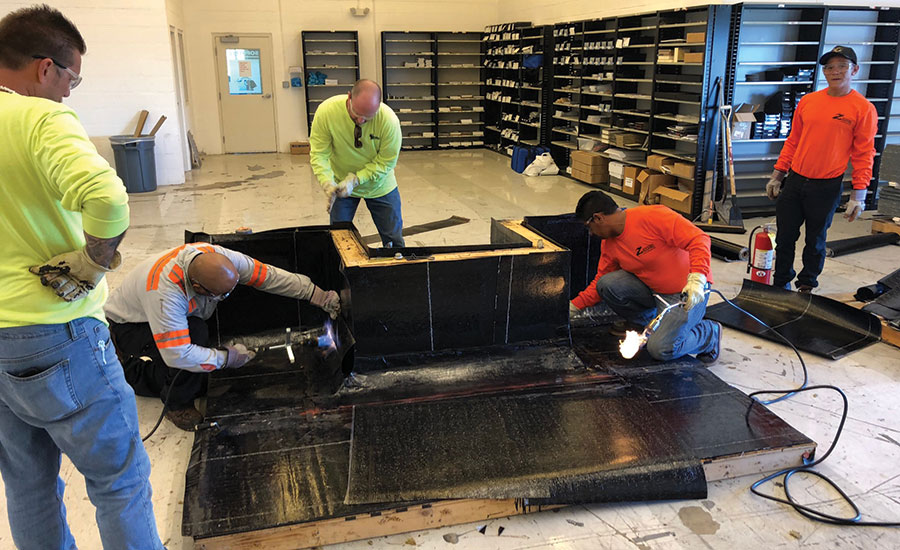Roofing contractors powered through the economic uncertainty of the past year and continue to show optimism in what 2024 — and the next few years — have in store for the roofing industry, according to the data fleshed out from RC’s annual nationwide survey of residential and commercial roofing contractors.
Seeking again to gauge the pulse of the roofing industry heading into a new year, the experts from Clear Seas Research — the survey and research arm of RC’s parent company, BNP Media — circulated the online survey last fall. The following 2024 State of the Industry Report, sponsored by our partners at Adams and Reese, highlights the key findings from a thorough analysis of responses.
The survey is designed to capture the perspectives of roofers on the successes and challenges they faced in 2023 while keeping an eye on the years ahead. Through the data, roofers can gain perspectives on sales trends, product development, workforce issues, innovations and more that are helping contractors find success today while planning for tomorrow. For the first time, this year’s study also explored homeowners’ thoughts and expectations surrounding the roofing consumer journey, which will be part of a future RC report (see preview page 62 Homeowner sidebar). Each contractor respondent received a $15 gift card for their participation.
We encourage everyone to join RC, Clear Seas CEO Mitch Henderson and Legal Insights Expert Trent Cotney of Adams and Reese for a live webinar on the 2024 SOI Report on February 15th at 2PM Eastern.
Sales Remain Solid
Just under three-quarters of all contractors reported year-over-year sales increases in 2023. Survey data showed that the number of those expecting increases again this year grew to 78%. For those looking further ahead, the number of contractors expecting sales increases over the next three years swelled to a bullish 87%.
Roofing contractors primarily focusing on residential work emphasized sales to gain ground on competitors in terms of market share and to take advantage of less-volatile material pricing following the supply crunch in 2022.
Three in five survey respondents say their residential sales increased in 2023 compared to the previous year, with even more expecting sales to rise over the next three years. Sixty-three percent of respondents predict 2024 will see increases in residential business, while 67% say residential sales will rise through 2026.
When narrowed down to respondents whose business is primarily residential — generating 50% or more revenue from non-commercial projects — contractors are even more optimistic about sales improving, riding that wave into the future. Of those respondents, 76% expect sales to “slightly or greatly” increase in 2023 over the previous year, while 79% expect the same to happen in 2024.
Only 17% believe sales will remain the same in 2024, and a smaller
number of respondents, just 3%, anticipate decreases.
When forecasting the next three years, 90% expect growth in total sales volumes. Regarding residential-specific sales, 86% of residential contractors anticipate increases through 2026, while 11% predict stagnant sales. The remaining 3% expect sales to drop over the next three years.
As fears of a recession waned with inflation declining and the overall U.S. economy performing well, commercial roofing appeared to surge in 2023. Sales stayed strong — about three-quarters of all respondents indicated sales remained steady or increased last year, and 26% said projected sales would significantly increase year-over-year.
About the same number of contractors said annual sales volume would increase next year, and 85% said sales should grow through 2026. Nearly 10% said sales volume decreased last year, including 4% that anticipated significant decreases.
Specifically, for 2024, about 7% of commercial roofing contractors expected sales to drop; fewer than that appeared pessimistic about roofing sales over the next three years. Of those contractors indicating optimism, 53% said revenues would “slightly increase” in 2024; that number increased to 68% when asked to project out to 2026.

Popular Products
The top product residential contractors expect to sell is steep-slope asphalt shingles, accounting for, on average, 32% of their revenue. Nearly three-fourths of residential contractors are involved in slinging shingles, though this is a decrease from 83% in 2023. Of them, 73% expect sales of shingles will increase in 2024.
In somewhat of a surprise, the second-biggest contributor to revenue on the residential side is low-slope asphalt, accounting for, on average, 17% of total revenue. Nearly seven of 10 (69%) residential contractor respondents include low-slope asphalt as a product offering. Of those offering low-slope, 62% believe those sales will increase in 2024.
The third product residential contractors are most involved with is single-ply roofing, with 66% of residential contractors using the product, though they say it’s only about 13% of their revenue. The most popular single-ply product used by residential roofers is TPO.
Metal roofing as a product offering appears to have dropped in popularity among residential roofers. Last year’s survey showed metal roofing as the most common roofing product among all respondents, with 81% saying they offer it. This year, it fell to the fourth most popular product, with 65% of all contractors saying they install metal roofing.
Despite the drop, 62% of residential contractors expect metal roofing sales to rise in 2024. In this year’s survey, 56% of residential roofers said they offer metal, but it only consists of, on average, 11% of their revenue. Architectural standing seam remains the most popular offering, with 26% of residential contractors saying it’s in their repertoire, followed by roof edge and gutter systems.
In the commercial realm, single-ply continues its dominance in the market, with about 81% of roofers indicating they install the product. Single-ply also accounted for the highest percentage of revenue generated by commercial roofers in the survey at 36%. The data showed that 41% of contractors installing TPO systems drove single-ply sales, followed by EPDM at 30% and PVC at 17%.
While coatings use dropped slightly to 59% from previous years, commercial roofers reported installing more polymer-synthetic roofs (41%) and slate roofs (37%), according to the data. That demonstrated double-digit gains in popularity among commercial roofers from the previous year. Coatings sales remained strong, with more than half, 54%, saying sales grew in 2023. About 60% of contractors using coatings indicated sales would increase next year.
Unlike residential contractors, commercial sales of metal roofing systems appear on the rise.
About 79% of respondents said they install metal roofs, accounting for 13% of their overall revenue.
Breaking it down by product, architectural standing seam projects accounted for 33% of sales, while roof edge and gutters were not far behind at 28%.
A correlated expectation of metal accessories sales use indicates anticipated growth in 2024.
In keeping with surprising trends, only 16% of residential roofing contractors say they are involved in solar, a drop from 20% in 2023. Despite the rising interest in solar power throughout the country, thanks to new incentives and lower prices, the complexities of installing solar roofing present challenges to market entry. Even so, some residential contractors, like Bone Dry Roofing in Indiana, have made inroads and are seeing success.
Judd Haag, director of Bone Dry Solar and Bone Dry Roofing’s chief information officer, told RC the company is taking things slow with solar, working out the standard operating procedures in the Indianapolis market before expanding. He said the industry is ripe with opportunities for contractors willing to invest, though he acknowledged it isn’t for everyone.
“Solar is such a new industry in general that there’s still a lot of stuff being figured out,” said Haag. “There’s a lot of contractors that [ramp] up, go out, sell systems, file bankruptcy within a year or two.”

Recruitment, Retention and Technology
While confidence in sales and roofing products appears high, some significant challenges facing roofing contractors now differ from just a year ago. Concerns about the overall economy topped the list, felt by slightly more than half, or 52%, of all contractors. Following closely behind were increased material costs at 49% and a lack of qualified workers at 46%.
More than a third of respondents identified “lowball pricing” and “bidding wars” as their chief concern, with supply chain issues rounding out the top five at 20%. Looking further into economic-related issues, seven in 10 contractors reported increased labor costs since January 2023, and 42% of those respondents said the spike was between 11-20%.
On average, the majority, 56%, of work companies completed was performed by full-time employees, followed by subcontractors at 32%, and part-time workers at 12%. The data showed that subs are used slightly more among respondents focusing on residential jobs (33%) than commercial (31%).
With “lack of qualified workers” being the third-highest concern for contractors — 46% of residential contractors listed it as a challenge — finding ways to hire and keep workers remains a top priority going into 2024.
Compounding the workforce issue is rising costs. Survey results show that residential contractors indicating they experienced an increase in labor costs saw, on average, a 17% rise in labor overhead.
Rising costs can be challenging for residential contractors that say full-time employees handle 54% of their field labor. As previously stated, residential contractors use subcontractors for about a third of the labor, with the rest, or 13%, handled by part-time workers.
The method residential contractors rely on most for finding new talent is “employee referrals,” with 64% of respondents tapping their employees for recommendations. From there, they turn to referrals from family and friends, at 51%, followed closely by online job postings on sites including Indeed and Craigslist. Some have become savvy with social media — 46% say they recruit through social channels. Only 18% of residential contractors turn to trade school affiliations.
Once an employee is hired, most contractors say they retain them with good pay and bonuses and ensure enough work. From there, 59% of residential contractors say “creating a safe work environment” is a good strategy. Despite rising labor costs, 43% of residential contractors provide benefits to keep workers on their crews.
When it comes to fostering a safe environment, 45% of residential contractors hold monthly safety meetings, while 21% hold weekly meetings to keep it on the top of employees’ minds. Only 21% say they hold safety meetings once yearly.
To further encourage safety on the job, 62% of residential contractors provide all required safety equipment, whereas 24% say they provide some equipment, and 11% depend on workers to have the equipment.
Technology continues to be a solution for roofing contractors seeking to work more efficiently and effectively amid labor shortages and rising costs. Startups like New York-based Renovate Robotics are developing robots that install shingles. However, the industry is still far from actual field work being completed by a fleet of machines.
For now, the closest roofers have to robots are drones. Though drone use is mainly seen in commercial roofing, 36% of residential survey respondents say they use drones for measurements or before-and-after photos. Chandler Steffy, owner of Iowa-based Superstorm Restoration, successfully developed Verified Data App, a mobile field application that uses drones to create detailed measurements and identify damage.
“The technology has artificial intelligence that identifies hail and wind damages, accessories, and maintenance needs,” Steffy said. “This makes estimating and proof of the condition of the home simplified and streamlined.”
Estimating software and enterprise business accounting software remain the most popular technology among all contractors at 70% and 68%, respectively. More than half of respondents also said they regularly use business process software, cloud computing and aerial measurement tools. Less than half said they regularly use Customer Relationship Management (CRM) software or drones.
Commercial roofing contractors appear to be driving technology adoption, demonstrating more than 51% use in each area. However, residential roofers are paying close attention and integrating more tech tools into business operations.
Estimation software remains the most commonly used technology
among residential contractors, with 64% saying they currently use it. Similarly, 64% of residential contractors use enterprise or accounting software to make operations smoother.
“We are constantly trying to improve our systems and technology to [stay] up with the times, to better our company as a whole and to make things run as [smoothly] as possible for our staff and sales team, our crews and our customers,” said Beth May, a bookkeeper with Ashco Exteriors, a 2023 Top 100 contractor from Minnesota.
That’s the path forward for the roofing industry in any market, said Richy Nelson, a third-generation roofing contractor who co-founded Roofr, a digital platform company that recently launched a CRM for roofers, which covers aerial imagery, measurements, proposals, contracts, payments, financing, and more.
“What I’m more excited about than anything is the rapid adoption of technology in roofing,” said Nelson, Roofr’s CEO. “It really does drive the best customer experience, and it also improves the margins and bottom lines of the roofing businesses.”
Editor’s Note: The information contained within this article comes from Clear Seas Research. 2023 Roofing Contractor Roofing Report. Oct. 2023.
Clear Seas Research is a full-service, B-to-B market research company focused on making the complex clear. Custom research solutions include brand positioning, new product development, customer experiences and marketing effectiveness solutions. Clear Seas offers a broad portfolio of primary, syndicated research reports and powers the leading B-to-B panel for corporate researchers, myCLEARopinion Panel, in the architecture, engineering, construction, food, beverage, manufacturing, packaging and security industries. Learn more at clearseasresearch.com.
www.roofingcontractor.com
https://www.roofingcontractor.com/articles/99113-roofing-contractors-continue-to-adapt-and-keep-sights-on-sales-in-evolving-marketplace















